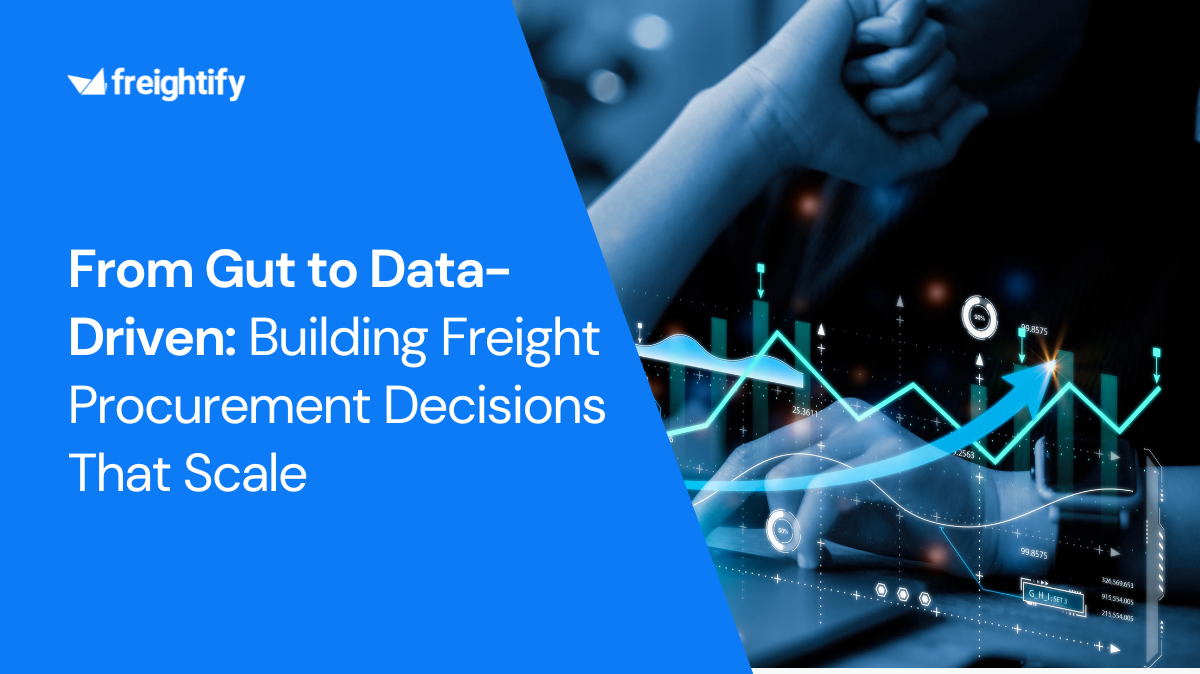Freight visibility is a crucial part of supply chain operations today.
In fact, according to an IBM report, 87% of Chief Supply Chain Officers (CSCOs) surveyed said that it’s difficult to predict and manage supply chain disruptions.
Whether it’s CSCOs or shippers, they need to know exactly where their freight is at all times to serve consumers most efficiently while avoiding disruptions.
Carriers, shippers, forwarders, and other stakeholders have invested in visibility tools that generate data as part of Web 3.0.
The need of the hour, though, keeping in mind uncertain events like COVID-19, or the Russia-Ukraine war, is real-time
Whether it is container tracking or rate management and procurement, data acquired in real-time gives forwarders and shippers the advantage.
What's in this article? Why is real-time freight visibility crucial to supply chains? How do freight forwarders benefit with end-to-end freight visibility data? Which data points can help freight forwarders avoid disruption? How can these data points help freight forwarders? So, how can freight forwarders get real-time data visibility? What are the benefits of freight data visibility for forwarders?
Let us help you with your journey
Your One Stop Solution to Manage Spot, Contract rates & Margins!
Why is real-time freight visibility crucial to supply chains? Data gathered through carrier networks (the norm in many cases) do not truly give real-time visibility to all the stakeholders involved.
Typically, this data can only be gathered when a vessel or a truck reaches a certain milestone. There is also the fact that many shippers and forwarders may not be ready to acquire real-time data due to outdated tech stacks in their TMS (transportation management systems).
This carrier-dependent milestone data leaves blind spots for shippers and forwarders. They lose out because they cannot track where inventory is located between the main checkpoints. These blind spots create bottlenecks for shippers, as they are unable to determine optimal rates for their cargo.
Gaining complete, accurate, and real-time independent data on the location and condition of the cargo – also known as ‘highly-reliable’ data – allows stakeholders to manage exceptions proactively and is in high demand among shippers and their customers now.
How do freight forwarders benefit with end-to-end freight visibility data? Freight forwarders have to balance various functions, including the booking of cargo space on ships, planes, trains, or trucks, coordinating insurance of the goods and doing the necessary follow-up in case of an accident, and overseeing the transportation of the cargo and its packing and loading into carriers, etc.
Apart from these functions, forwarders also play a crucial role in helping their clients, shippers, and exporters with various logistics-related expenses.
They may offer guidance on freight expenses, documentation and customs expenses, demurrage fees, port expenses, insurance costs, and more. In order to provide accurate guidance and ensure their bottom line stays consistent, forwarders need data visibility in real-time.
End-to-end freight visibility data allows them to anticipate inefficiencies, track freight accurately and mitigate possible disruptions simultaneously.
Which data points can help freight forwarders avoid disruptions? End-to-end freight visibility brings real-time transparency to various aspects of the supply chain.
Freight forwarders need to look at the perishable nature of the goods, transit cost, time, and safety of the goods to suggest the best possible route for the shipment to the exporter.
Access to freight data in real-time can help them study these various factors and provide the best possible services and rates to existing customers.
Forwarders also need to advise clients on the various processes around shipping and logistics.
For this, they need access to accurate container tracking and freight data in addition to visibility into transit times, ETAs, trans-shipping, container or cargo conditions, equipment availability, etc.
All this data ultimately leads to a more informed and accurate benchmarking of rates, with forwarders able to provide more lucrative and efficient service.
How can these data points help freight forwarders? Various inefficiencies can pop up when there is a lack of visibility data. These include:
Fluctuations in container prices and freight rates due to global disruptions Unforeseen supply chain disruptions often result from global black swan events or market movements. For example, the COVID-19 pandemic brought supply chain and logistics networks to a standstill globally.
94% of Fortune 1000 companies reported supply chain disruptions from COVID-19 As a result, businesses had to find alternative measures to overcome delays. Vehicles and vessels were delayed by days due to port closures.
Meanwhile, issues like port congestion and driver shortage were only exacerbated.
With 62.1% loss of productivity and 42% loss of revenues as found by a BCI report , supply chain disruptions have led to long-term fluctuations in container and shipping rates.
Not having visibility into freight data during these uncertain times can thus result in higher costs.
Conversely, having relevant data related to container and freight conditions can lead to more efficient price management for forwarders and their clients.
Logistics inefficiencies lead to monetary losses According to a report, business logistics prices rose by 22% in 2021.
This includes various aspects of logistics and supply chain networks, with exploding demurrage and detention charges, higher carrier rates, and more. The main reason for these rising costs can be attributed to a lack of data visibility.
Issues like port congestion and lack of personnel mean containers will sit, waiting for last-mile transit at depots for days.
Not only are the ports congested, but freight shipping yards are also packed to capacity, and the congestion is spilling over to railway networks as a result. Forwarders and shippers lack real-time vision on various shipments in transit and other stages. All of this can lead to delays of days at a time.
Companies lose money due to operational inefficiencies and manual planning processes, which leads to hidden, escalating costs that add up and take a tremendous toll on bottom lines.
Customer expectations are evolving, so forwarders and carriers must evolve to stay relevant Not keeping track of container rates and various shipment metrics like which liners have late vs. best delivery times can lead to compounding losses.
Forwarders run the risk of not satisfying consumers and losing business. Exporters want the best rates for all their port clearance and freight needs.
Performance data points like rate quotes, bookings, TEUs, and best-performing products per geography, among others, help forwarders know what can propel their own business forward. These points help them figure out the most effective rate management practices.
Missing out on business opportunities Whether it is a lack of collaboration between stakeholders, human errors and negligence, or inaccurate data, all these factors can cause freight forwarders and shippers to lose valuable business.
Real-time tracking of various data points allows forwarders to gather insights and information that can be used for future business as well. Data visibility allows stakeholders to predict possible problem areas, anticipate risks and solve them effectively.
The simple functionality to predict shipment ETAs and schedule new bookings based on accurate information about this can be the difference between gaining a new business and losing out.
Lack of visibility keeps forwarders unaware of these opportunities.
Let us help you with your journey
Instantly procure spot rates from 30+ LCL and FCL Carriers & NVOCCs
So how can freight forwarders get real-time data visibility? There are many software tools and APIs that can be connected to existing systems to get real-time data visibility.
Forwarders can use automatic systems for transportation, freight management, and more to estimate arrival and departure times, vessel details, cargo details, and market information.
Forwarders can find freight predictions and forecasts, current rates and benchmarks , spot rates, etc., By using an exchange portal integrated into these management systems. This is an effective way to improve efficiency for forwarders and agents.
Freightify , a digital solution, can help forwarders with various functions, including:
Rate procurement and management Benchmarking best rates Instant quotation engineTracking vessels Seamless TMS integration These tools and functionalities give forwarders an edge in business with the relevant data visibility.
Stakeholders no longer need to rely on 3rd party data to get clarity and visibility. Instead, they can optimize rates and gain an advantage over the competition.
What are the benefits of freight data visibility for forwarders? Track vessel ETAs and predictions in real-time to get the best rates Tracking cargo and freight in real-time tells forwarders when their freight will arrive, when the vessel will berth, the customs requirements, and other necessary details. This allows them to procure and offer the best rates depending on the market conditions.
Utilizing this data can also help forwarders with specific exporters and clients by tracking individual trends based on goods to be ferried. As a result, forwarders can improve efficiency, manage schedules and get the best rates for their customers.
For instance, forwarders can use a freight API integration like Freightify LINK, Freightify's API product, which helps retrieve the rate schedule information through an API into an existing system. Some of the benefits of using an API integration like LINK include:
Instant access to live rates of shipping liners A single format to consume for the contract sheet rates and live rates of different liners Easy integration with existing systems Reduction in the time to go to market Track cargo information in real-time to optimize rate schedules Tracking cargo details allows a shipper or a forwarder to know if they will be transporting perishable goods, whether there is a risk of damage or breakage, and other such details.
This information can help forwarders make smart decisions about route tracking, berthing, cargo handling, ferrying from ocean to rail to road, etc. As a result, forwarders can get better ROIs.
To summarize, forwarders can get an unprecedented advantage in terms of increasing revenues and saving costs with data visibility.
Forwarders, agents, and brokers need to start using technology to bridge the logistics gap and acquire real-time, actionable freight data.
Investing in APIs and integrations like Freightify is a great method to leverage smart rate management .
Not only can companies and forwarders make more insightful decisions with this real-time data, but they can “future-proof” their operations, making them more resilient against coming challenges.




















